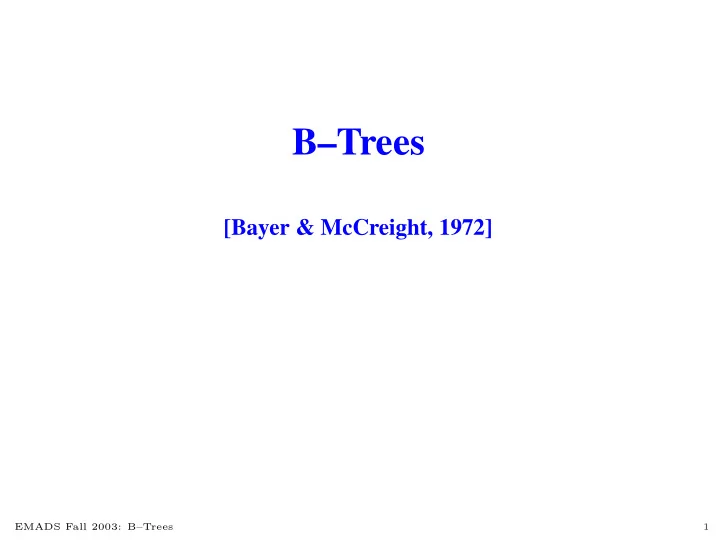

B–Trees [Bayer & McCreight, 1972] EMADS Fall 2003: B–Trees 1
An Application of B–Trees Core indexing data structure in many database management systems TELSTRA, an Australian telecommunications company, maintains a customer database with 51.000.000.000 rows and 4.2 terabytes of data EMADS Fall 2003: B–Trees 2
( a, b ) –Trees and B–trees [Bayer & McCreight, 1972] 7 14 3 5 9 12 13 15 17 2 4 5 8 10 12 13 14 16 17 A tree is an ( a, b ) –tree if a ≥ 2 , b ≥ 2 a − 1 and Definition • All leaves have the same depth. • All internal nodes have degree at most b . • All internal nodes except the root have degree at least a . • The root has degree at least two. ( a, 2 a − 1) –trees are also denoted B–trees EMADS Fall 2003: B–Trees 3
Properties of ( a, b ) –Trees 7 14 3 5 9 12 13 15 17 2 4 5 8 10 12 13 14 16 17 � � � (log n ) − 1 � log n N leaves implies ≤ height ≤ + 1 Lemma log b log a Searches require O (log a n ) I/Os if b = O ( B ) Lemma EMADS Fall 2003: B–Trees 4
Updates in ( a, b ) –Trees • Search for location to insert or delete a leaf • Create/delete leaf and search key at the parent node • Rebalance using the following transformations Split � b +1 � b +1 b + 1 � � 2 2 Share a − 1 > a ≥ a a Fusion a a − 1 2 a − 1 EMADS Fall 2003: B–Trees 5
Example : Insert into a (2,4)–Tree 7 14 3 5 9 12 13 15 17 2 4 5 8 10 12 13 14 16 17 ⇓ Insert(11) 7 12 14 3 5 9 11 13 15 17 2 4 5 8 10 11 12 13 14 16 17 EMADS Fall 2003: B–Trees 6
Analysis of ( a, b ) –Trees – Insertions Only Theorem n insertions imply n/ ⌊ ( b + 1) / 2 ⌋ h splits at height h i.e. in total O ( n/b ) splits Proof • Nodes are created due to splits • All nodes except the root has degree at least ⌊ ( b + 1) / 2 ⌋ h • The number of nodes in the lowest level dominates all other levels ✷ EMADS Fall 2003: B–Trees 7
Analysis of ( a, b ) –Trees If b ≥ 2 a , then i insertions and d deletions perform at Theorem most O ( δ h ( i + d )) splits and fusions at height h , where δ < 1 depends on a and b Amortization argument, each node has a potential φ Proof (sketch) (= measure of unbalancedness) φ 1 + δ 1 1 2 δ 1 δ 2 1 1 degree a − 1 a − 1 b + 1 α β ✷ 2 If b ≥ 2 a , then the total # splits and # fusions is O ( i + d ) . Theorem If b ≥ (2 + ε ) a , for some ε > 0 , the number of node splittings and node fusions is O ( 1 a ( i + d )) EMADS Fall 2003: B–Trees 8
Analysis of ( a, b ) –Trees Theorem ( B/ 3 , B ) –trees perform Θ(1 /B ) rebalancing per update Theorem ( ⌊ B/ 2 ⌋ , B ) –trees perform Θ(1) rebalancing per update Theorem ( ⌈ B/ 2 ⌉ , B ) –trees perform Θ(log B N ) rebalancing per update if B odd EMADS Fall 2003: B–Trees 9
Lower Bound for Searching Theorem Searching for an element among N elements in external memory requires Ω(log B +1 N ) I/Os Proof (sketch) • Adversary argument • Algorithm knows total order of stored elements • Initially all elements are candidates for being the query element • If prior to an I/O there are C candidate elements left, then there � � C − B candidates after reading B elements exists anwers leaving B +1 ✷ The lower bound holds even if an I/O can read B arbitrary Note elements from memory EMADS Fall 2003: B–Trees 10
Recommend
More recommend